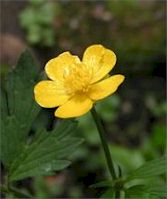 |
The most common Buttercup of our fields (Ranunculus bulbosis) needs no detailed description. It belongs to the order termed Ranunculaceoe, so-called from the Latin rana, a frog, because the several varieties of this genus grow in moist places where frogs abound. Under the general name of Buttercups are included the creeping Ranunculus, of moist meadows; the Ranunculus acris, Hunger Weed, or Meadow
Crowfoot, so named from the shape of the leaf (each of these two being also called King Cup), and the Ranunculus bulbosus mentioned above. "King-Cob" signifies a resemblance between the unexpanded flowerbud and a stud of gold, such as a king would wear; so likewise the folded calyx is named Goldcup, Goldknob and Cuckoobud. The term Buttercup has become conferred through a mistaken notion that this flower gives butter a
|
yellow color through the cows feeding on it (which is not the case), or, perhaps, from the polished, oily surface of the petals. The designation really signifies "button cop," or bouton d'or; "the batchelor's button"; this terminal syllable, cup, being corrupted from the old English word "cop," a head. It really means "button head." The Buttercup generally is known in Wiltshire and the adjoining counties as Crazy, or Crazies,
being reckoned by some as an insane plant calculated to produce madness; or as a corruption of Christseye (which was the medieval name of the Marigold).
A burning acridity of taste is the common characteristic of the several varieties of the Buttercup. In its fresh state the ordinary field Buttercup is so acrimonious that by merely pulling up the plant by its root, and carrying it some little distance in the hand, the palm becomes reddened and inflamed. Cows will not eat it unless very hungry, and then the mouth of the animal becomes sore and blistered. The leaves of the Buttercup, when
bruised and applied to the skin, produce a blistering of the outer cuticle, with a discharge of a watery fluid, and with heat, redness, and swelling. If these leaves are masticated in the mouth they will induce pains like a stitch between the ribs at the side, with the sharp catching of neuralgic rheumatism. A medicinal tincture is made (H.) from the bulbous Buttercup with spirit of wine, which will, as a similar, cure _shingles_ very
expeditiously, both the outbreak of small watery pimples clustered together at the side, and the accompanying sharp pains between the ribs. Also this tincture will promptly relieve neuralgic side-ache, and pleurisy which is of a passive sort. From six to eight drops of the tincture may be taken with a tablespoonful of cold water by an adult three or four times a day for either of the aforesaid purposes. In France, this plant is called "jaunet."
Buttercups are most probably the "Cuckoo Buds" immortalized by Shakespeare. The fresh leaves of the Crowfoot (Ranunculus acris) formed a part of the famous cancer cure of Mr. Plunkett in 1794. This cure comprised Crowfoot leaves, freshly gathered, and dog's-foot fennel leaves, of each an ounce, with one drachm of white arsenic levigated, and with five scruples of flowers of sulphur, all beaten together into a paste, and dried by the
sun in balls, which were then powdered, and, being mixed with yolk of egg, were applied on pieces of pig's bladder. The juice of the common Buttercup (Bulbosus), known sometimes as "St. Anthony's Turnip," if applied to the nostrils, will provoke sneezing, and will relieve passive headache in this way. The leaves have been applied as a blister to the wrists in rheumatism, and when infused in boiling water as a poultice over the pit of
the stomach as a counter-irritant. For sciatica the tincture of the bulbous buttercup has proved very helpful.
The Ranunculus flammata, Spearwort, has been used to produce a slight blistering effect by being put under a limpet shell against the skin of the part to be relieved, until some smarting and burning have been sensibly produced, with incipient vesication of the outermost skin.
The Ranunculus Sceleratus, Marsh Crowfoot, or Celery-leaved Buttercup, called in France "herbe sardonique," and "grenouillette d'eau," when made into a tincture (H.) with spirit of wine, and given in small diluted doses, proves curative of stitch in the side, and of neuralgic pains between the ribs, likewise of pleurisy without feverishness. The dose should be five drops of the third decimal tincture with a spoonful of
water every three or four hours. This plant grows commonly at the sides of our pools, and in wet ditches, bearing numerous small yellow flowers, with petals scarcely longer than the calyx.
Herb Simples
The Primitive Simplers presented here show the way of life in other generations, it is not suggested or recommended trying them yourself. |


